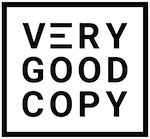![VeryGoodCopy [Logo] DARK.png](https://images.squarespace-cdn.com/content/v1/5615edeae4b0b9df5c3d6e90/1530152264592-RF9CLF240JWIUSTWGEBP/VeryGoodCopy+%5BLogo%5D+DARK.png)
Good copy carves a path to an emotion, a feeling.
A copywriter’s purpose, then, is to identify the words and concepts that create the shortest possible path to this emotion — a process that hinges on word choice and, of course, brevity.
So the copywriter’s work is about paring down adverbs and adjectives. It’s about not using 2 or 3 words when 1 will do. It’s about cutting corners — conceptually and technically — to make the point faster, better, smarter.
A copywriter’s work is about crafting clear, concise sentences.
This, of course, doesn’t come naturally.
Writing this way is a learned skill. It’s the product of practice and grit.
![The exercise will train you to write more concisely [VGC art].JPG](https://images.squarespace-cdn.com/content/v1/5615edeae4b0b9df5c3d6e90/1530152650733-6R8LN44UDC80O1JGCQPE/The+exercise+will+train+you+to+write+more+concisely+%5BVGC+art%5D.JPG)
If your goal is to write tighter copy — copy that says more in fewer words — try this 15-minute exercise.
Do it once a day, five days a week for a month, and your writing will improve.
Do it once a day, five days a week for a year, and the quality of your writing will surpass that of most professional copywriters.
The Wikipedia paragraph rewrite
The instructions are straightforward: rewrite a Wikipedia paragraph to a third of its original length (e.g., edit ~150 words down to ~50 words) without sacrificing its meaning.
For example, I started with this 175-word paragraph from HubSpot’s Wikipedia page:
HubSpot was founded by Brian Halligan and Dharmesh Shah at the Massachusetts Institute of Technology (MIT) in 2006. Shah invested $500,000, which was followed by angel investments from Edward B. Roberts, the chair of the Entrepreneurship Center at MIT and fellow MIT Sloan classmate and Entrepreneur Brian Shin. The company introduced the HubSpot software in beta in 2006 and officially launched it in December 2007. An additional $5 million in funding was raised in 2007, which was followed by $12 million in May 2008, and $16 million in late 2009. The company grew from $255,000 in revenues the first year the software was released to $15.6 million in 2010. Later that year HubSpot announced its acquisition of oneforty. Oneforty began as an app store for Twitter, but shifted into an online resource for social media marketing. The company also introduced new software for personalizing websites to each visitor. According to Forbes, HubSpot started out targeting companies of 1–10 employees, but "moved steadily upmarket to serve larger businesses of up to 1000 employees."
And I condensed it down to 52 words:
Founded by Brian Halligan and Dharmesh Shah at MIT in 2006, HubSpot received a series of multi-million dollar capital injections that helped it grow more than 60X in its fourth year of business. That same year, HubSpot announced its acquisition of oneforty, introduced new website-personalization software, and began targeting much bigger businesses.
That’s one repetition. Aim for five a week.
Why is this exercise so effective?
One of Wikipedia’s essential publication rules is “Be concise.”
“Articles should use only necessary words,” explains the Rules section. “This does not mean using fewer words is always better; rather, when considering equivalent expressions, choose the more concise.”
In other words, Wikipedia already has a strict no-fluff policy — and that’s what makes this exercise so effective.
Editing an already-concise paragraph for brevity demands hypersensitivity to syntax, to sentence structure, to the weight of each word.
It puts your Editor Brain into overdrive, forcing a mindset so foreign and unnatural, that you’ll walk away from every exercise a markedly more cognizant and judicious writer.
Give it a try. And feel free to subscribe to the VeryGoodCopy newsletter for more free, practical copywriting tips.

LEARN TO PERSUADE
✅ Join thousands of email subscribers
✅ Less than 0.4% of readers unsubscribe
✅ Never miss a Micro-Article or -Interview
✅ Get instant email access to VGC's founder
✅ Be first in line to get new, free Micro-Courses
DRAYTON BIRD
Global Creative Director @ Ogilvy & Mather
BEN SETTLE
Email Marketing Master
KIM KRAUSE SCHWALM
A-List Direct Response Copywriter
RYAN BONNICI
Forbes 26th Most Influential CMO
SCOTT DIKKERS
Founding Editor @ The Onion 🧅
LISA PIERSON
Partner @ CopyHackers Agency
JUSTIN WELSH
SaaS Advisor & Writer
GODARD ABEL
CEO @ G2.com
DAVID GARFINKEL
A-List Direct Response Copywriter
JORGE SELVA
Director of Growth @ Help Scout
ADAM GOYETTE
Chief Marketing Officer @ Help Scout
TYLER J. KOENIG
Conversion Copywriter
TOMMY WALKER
Editor-in-Chief @ Shopify Plus & CXL
JASON VANA
Founder @ SHFT Marketing
JUSTIN BLACKMAN
Founder @ Pretty Fly Copy
CAMILLE TRENT
Managing Editor @ MarketerHire
NIKHIL NARAYANAN
Creative Director @ Ogilvy & Mather
EDEN BIDANI
Copywriter @ Greenlight Copy
MARK KILENS
VP of Content @ Drift































